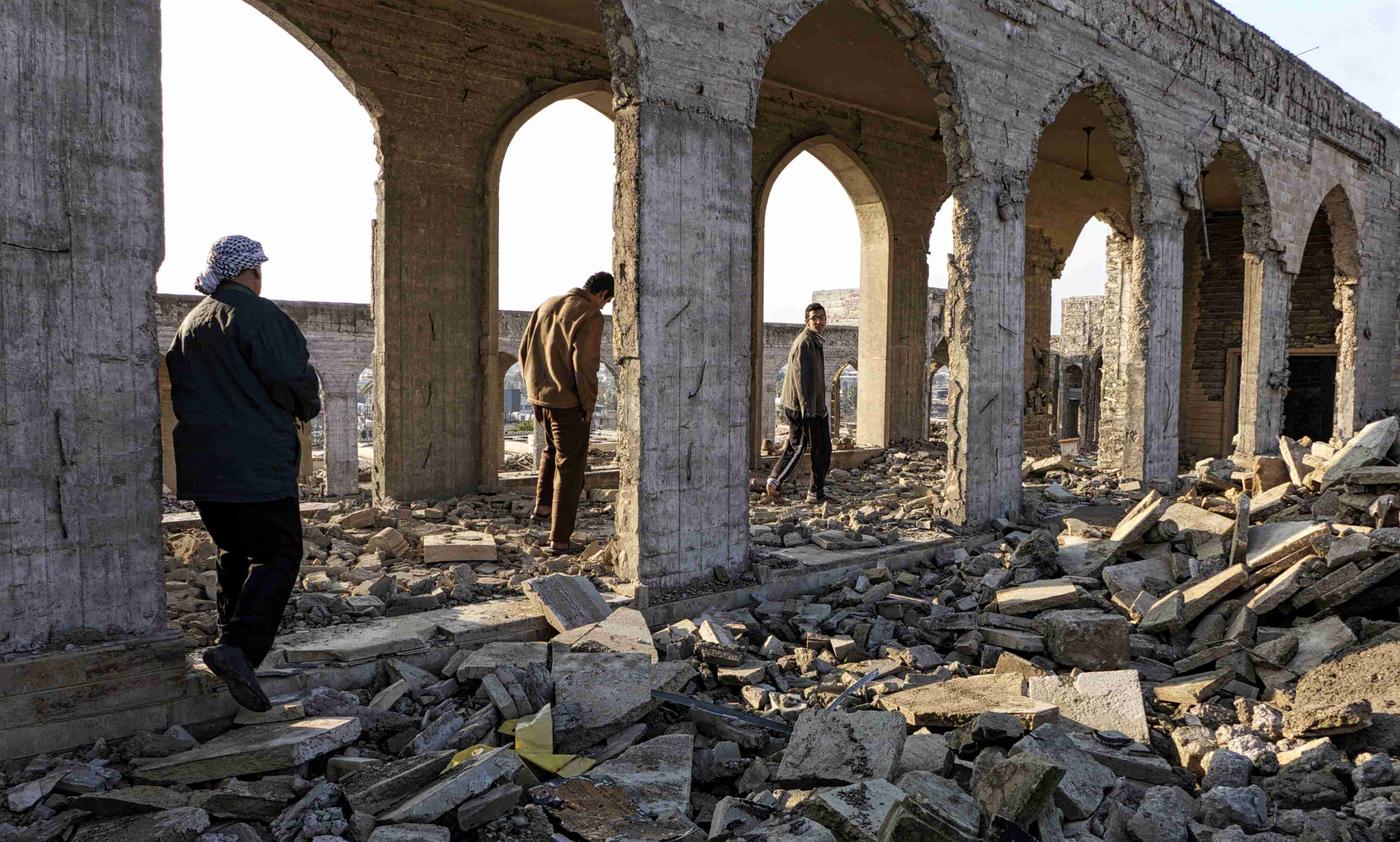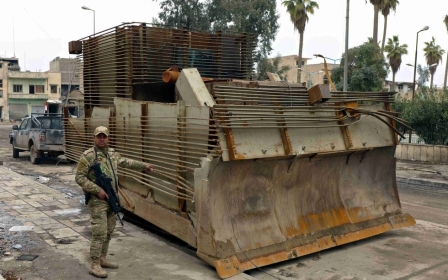Jonah's ancient tomb in Mosul: 'When IS blew it up, I cried for three days'
In the late afternoon sunshine, Iraqi soldiers, taking a break from the Mosul frontline, pile out of Humvees to pose for selfies by the ruins of the once-famous shrine of Jonah’s Tomb.
The tomb is dedicated to the memory of the Old Testament prophet, revered by both Christians and Muslims alike (in Islam, Jonah is commonly known as "Yunus"). Jonah preached in Iraq but is best remembered for having survived being eaten by a whale.
Islamic State (IS) blew up the ancient mosque of Nabi Younis, built around the purported grave of Jonah (or Younis), after seizing control of Mosul in July 2014.
Built upon the ruins of a former Assyrian church, the mosque was one of countless Sunni, Shia and Christian places of worship the terror group desecrated in the city.
For two-and-half years, even visiting the ruins of the mosque was prohibited. But, since the liberation of Mosul’s Nabi Younis district in January, the rubble remains of the mosque have been given a new lease of life, attracting hundreds of soldiers and residents.
'Whenever we were sick or sad, my mother would bring us here and we would always leave happy'
- Abu Neshwan
Abu Neshwan, 70, was visiting the site for the first time in almost three years, assisted by a friend who helped him clamber over the rubble.
For centuries the site, which is known for its ornate sepulchre coverings and richly decorated interior, attracted thousands of Christian and Muslim pilgrims and tourists every year.
Neshwan recalled how many Iraqis performing Hajj to Mecca would first spend two days at the Nabi Younis mosque, stopping there again on their return journey.
“I have been coming here since I was a baby," he told MEE. "Whenever we were sick or sad, my mother would bring us here and we would always leave happy,” he added, fingering prayer beads as tears rolled down his face.
Wanton destruction
There has been a city where Mosul now stands for 4,000 years. At one point, Nineveh - now part of the modern-day metropolis's central hub - was briefly the biggest city in the world.
The region is rich in archaeological treasures, which have been threatened by years of conflict.
Mosul residents who live near the hilltop site described how IS militants looted the premises. The group lectured locals on the ills of worshipping in a building containing a tomb, before blowing it up with a huge pile of incendiary explosives.
Ibrahim, 26, said: “I watched them taking out all the historic things from the shrine, loading them into a big truck, before they prepared the explosives to blow it up.”
“I saw the whole thing,” said Mohammed, 51, who lives in one of the humble nearby dwellings. “They came here with explosives and canisters of petrol and connected it all with wires before detonating it from a distance.
“They told us it was forbidden in Islam to have a grave inside a mosque, and said it meant we were praying to a tomb instead of directly to God.”
At a meeting in Paris last month, Iraqi officials and dozens of world experts agreed to work together and restore the ransacked and destroyed cultural treasure.
The Iraqi Culture Minister Salim Khalaf said last month that more than 700 items are estimated to have been looted from the tomb alone.
For locals, the despair goes deeper.
'There were copies of the Quran lying on the ground. They never even picked them up and yet they call themselves Muslims'
- Mohammed
“This was our prophet because we believe in the prophets,” said Mohammed, “but we could do nothing to stop them and we couldn’t even say anything because we would have been arrested and punished.
“After they left, I walked in the ruins and everything was destroyed. There were copies of the Quran lying on the ground. They never even picked them up and yet they call themselves Muslims.”
Neshwan added: “When Daesh [IS] blew it up, we saw the huge flash of the explosion from the town below and I cried for three days.”
Ancient Assyrian palace
After reducing the site to rubble, IS militants tunnelled underneath it, creating part of an extensive underground network in preparation for their defence of Mosul.
Iraqi archaeologists recently entered those tunnels - and found that they led into a previously undiscovered ancient Assyrian palace believed to date back to around 600BC.
Spanish photographer Andoni Lubaki was one of a handful of western journalists who entered the palace. “There were a lot of carved reliefs on the walls, including two headless horses, some figures and inscriptions in Aramaic," he told MEE.
“There was a collection of ancient artefacts on the floor, which looked as though they had been amassed by IS, possibly to sell, and a lot of children’s bones. One of the archaeologists said it could have been an ancient cemetery reserved for children.”
Lubaki said there was evidence that IS had been using the underground palace as a base, and that their clothes and shoes were still strewn around. A pungent odour emanating from rotting IS corpses permeated the air and made it difficult for anyone to spend more than a few minutes in the chamber.
“We went down to the first level and entered a large chamber which had three further tunnels running off it. We couldn’t go any further because newly collapsed sections showed it was clearly unstable. When a mortar fell in a distant neighbourhood, sand trickled down from the ceiling."
“After speaking to UNESCO, Iraqi archaeologists decided to seal off the tunnel to protect the remaining artefacts there from robbers or further damage.” Lubaki added that it was believed some historic items had already been plundered since the area had been liberated.
Lubaki said the Iraqi archaeologists believed the ancient palace had further levels going deeper into the hillside but said that the structure had become too unstable to risk further exploration at present.
Hopes for reconstruction
Wandering along one of the few colonnades which survived the blast, Mosul citizens wistfully recalled the pre-IS summer days, when visitors flocked to the site to perform simple prayer rituals, walking around the shrine, praying with open hands and touching the grave.
“Muslims and Christians came from all over Iraq and all over the world - from Turkey, India and Europe - to visit this shrine. Sometimes there would be as many as a thousand in a single day,” said Mohammed.
He described how the palm-fringed stepped slope of the hillside upon which the mosque was built was a popular site for family picnics in the summer months. “If you came here on a Friday, you couldn’t even get inside, it was so busy. We had such beautiful days here.”
Widespread elation at the liberation of eastern Mosul has not been tarnished by the discovery of the full damage IS inflicted upon nearby historic and religious sites.
Despite their sorrow at seeing the rubble of the mosque, most visitors spoke with optimism about the possibility of rebuilding their once-sacred shrine. Mohammed said a wealthy benefactor in another Arab country had already pledged funds towards the reconstruction of the Nabi Younis mosque.
For his part Abu Neshwan promised that if the shrine was rebuilt then he would slaughter a sheep in celebration and give the meat to the poor.
Then he climbed back over the rubble to start his slow descent back down into eastern Mosul.
This article is available in French on Middle East Eye French edition.
Middle East Eye propose une couverture et une analyse indépendantes et incomparables du Moyen-Orient, de l’Afrique du Nord et d’autres régions du monde. Pour en savoir plus sur la reprise de ce contenu et les frais qui s’appliquent, veuillez remplir ce formulaire [en anglais]. Pour en savoir plus sur MEE, cliquez ici [en anglais].








